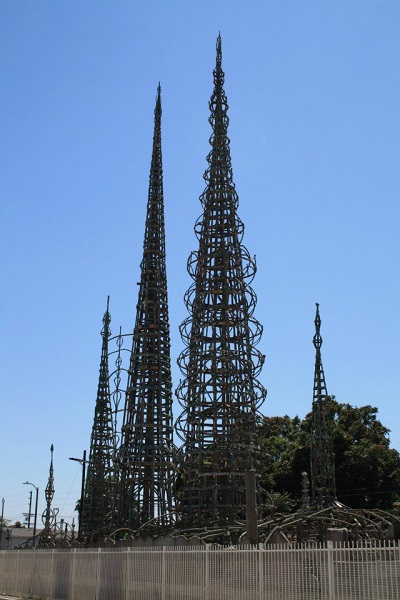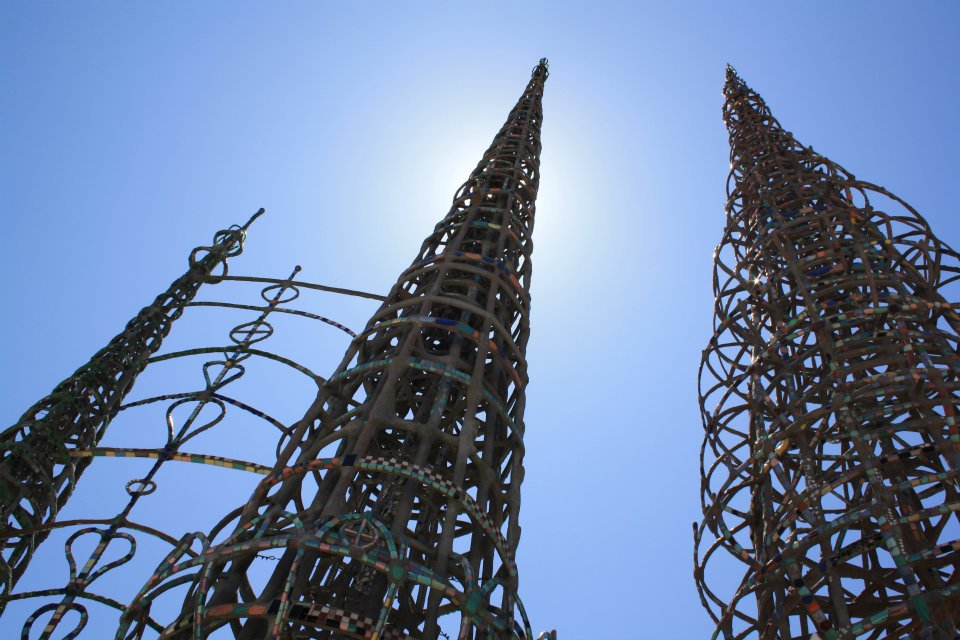Watts Towers
The Watts Towers are an installation of sculptures, towers and walls located in the Watts area of Los Angeles, California. They were built single-handedly by local resident Simon Rodia over a period of 34 years, beginning in 1921. The installation is remarkable for having been built without mechanical equipment, scaffolding or drawn designs. Instead, Rodia used simple tools and everyday items such as scrap steel, bed frames, pipes, and broken glass.
There are 17 major sculptures constructed of structural steel, wrapped with wire mesh and covered with mortar. The tallest of the towers reaches a height of 30 m (99.5 ft) and contains the longest slender reinforced concrete column in the world. His ‘ship of Marco Polo’ includes a spire that reaches 28 ft.
The sculptures are elaborately decorated with a Gaudi-esque array of ‘found objects’, such as broken bottles, ceramics, sea shells, pottery, tiles, and much more besides.
When Rodia, aged 75, moved away from Watts, the City of Los Angeles ordered that the towers should be demolished on safety grounds. But local campaigners devised a strength test to demonstrate their stability. A crane tried to pull them over but both it and its steel hawser buckled, and so the authorities decided to let them remain.
The local community then formed the Watts Towers Arts Center to preserve the installation. They are now listed on the Natural Register of Historic Places as a National Historic Landmark of Los Angeles.
[edit] Related articles on Designing Buildings Wiki
- A House for Essex.
- Building of the week series.
- Calakmul Corporate Building, Mexico.
- Ceramics.
- Dali Theatre and Museum.
- Dancing House, Prague.
- Dennis Severs house.
- Little Crooked House, Poland.
- Lotus Temple.
- Luxor Las Vegas.
- Recycling.
- Space Needle.
- Sustainable materials.
- The Big Basket.
- Theme Building, LAX
- Unusual building design of the week.
- Waldspirale.
[edit] External references
Featured articles and news
British Architectural Sculpture 1851-1951
A rich heritage of decorative and figurative sculpture. Book review.
A programme to tackle the lack of diversity.
Independent Building Control review panel
Five members of the newly established, Grenfell Tower Inquiry recommended, panel appointed.
Welsh Recharging Electrical Skills Charter progresses
ECA progressing on the ‘asks’ of the Recharging Electrical Skills Charter at the Senedd in Wales.
A brief history from 1890s to 2020s.
CIOB and CORBON combine forces
To elevate professional standards in Nigeria’s construction industry.
Amendment to the GB Energy Bill welcomed by ECA
Move prevents nationally-owned energy company from investing in solar panels produced by modern slavery.
Gregor Harvie argues that AI is state-sanctioned theft of IP.
Heat pumps, vehicle chargers and heating appliances must be sold with smart functionality.
Experimental AI housing target help for councils
Experimental AI could help councils meet housing targets by digitising records.
New-style degrees set for reformed ARB accreditation
Following the ARB Tomorrow's Architects competency outcomes for Architects.
BSRIA Occupant Wellbeing survey BOW
Occupant satisfaction and wellbeing tool inc. physical environment, indoor facilities, functionality and accessibility.
Preserving, waterproofing and decorating buildings.






















